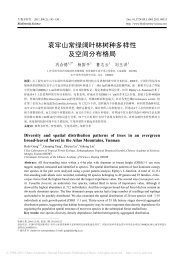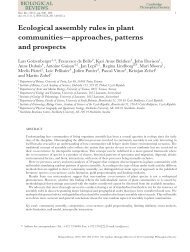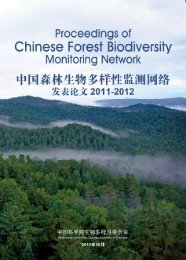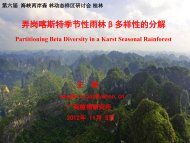the maintenance of species-richness in plant communities
the maintenance of species-richness in plant communities
the maintenance of species-richness in plant communities
You also want an ePaper? Increase the reach of your titles
YUMPU automatically turns print PDFs into web optimized ePapers that Google loves.
Ma<strong>in</strong>tenance <strong>of</strong> <strong>species</strong>-<strong>richness</strong> <strong>in</strong> <strong>plant</strong> <strong>communities</strong> 131<br />
tree Frax<strong>in</strong>us excelsior <strong>in</strong> woodlands on boulder clay <strong>in</strong> eastern England (Wade, 1g59),<br />
but <strong>in</strong> an unusually wet spr<strong>in</strong>g <strong>the</strong> Mercurialis dies back on marg<strong>in</strong>al sites (Mart<strong>in</strong>,<br />
1968) and Fram‘nw, which is tolerant <strong>of</strong> waterlogg<strong>in</strong>g, can <strong>the</strong>n grow through. The<br />
many relationships <strong>of</strong> this k<strong>in</strong>d, which must contribute to <strong>the</strong> <strong>ma<strong>in</strong>tenance</strong> <strong>of</strong> diversity,<br />
have hardly begun to be explored.<br />
VII. DISCUSSION<br />
There can be no serious doubt that <strong>the</strong> k<strong>in</strong>ds <strong>of</strong> differences between <strong>species</strong> <strong>in</strong><br />
regeneration requirements considered <strong>in</strong> this review contribute a f<strong>in</strong>ite amount to <strong>the</strong><br />
<strong>ma<strong>in</strong>tenance</strong> <strong>of</strong> <strong>species</strong>-<strong>richness</strong> <strong>in</strong> <strong>plant</strong> <strong>communities</strong>. The examples given all concern<br />
<strong>the</strong> regeneration <strong>of</strong> seed <strong>plant</strong>s, but a parallel case could be made out for <strong>the</strong> pteridophytes,<br />
bryophytes, attached algae or fungi and <strong>in</strong>deed for corals and o<strong>the</strong>r attached<br />
animals. The really difficult problem is to establish that any two <strong>species</strong> may co-exist<br />
<strong>in</strong>def<strong>in</strong>itely on <strong>the</strong> basis <strong>of</strong> differences <strong>in</strong> <strong>the</strong> regeneration niche. If <strong>species</strong> A always<br />
tends to oust <strong>species</strong> B over a period <strong>of</strong> years <strong>in</strong> a particular part <strong>of</strong> <strong>the</strong> world, when<br />
<strong>in</strong>dividuals <strong>of</strong> <strong>the</strong> same physiological age are matched aga<strong>in</strong>st each o<strong>the</strong>r, what are <strong>the</strong><br />
conditions necessary for differentiation <strong>in</strong> <strong>the</strong> regeneration niche to be a basis <strong>of</strong><br />
<strong>in</strong>def<strong>in</strong>ite co-existence? There are two major conditions. The first is that B must be<br />
able to persist <strong>in</strong> <strong>the</strong> community as long as <strong>the</strong> mean time between those events which<br />
cause ei<strong>the</strong>r <strong>the</strong> creation <strong>of</strong> a gap <strong>of</strong> a k<strong>in</strong>d which favours <strong>the</strong> establishment <strong>of</strong> B more<br />
than A or <strong>the</strong> creation <strong>of</strong> a gap at a place where B has propagules and A has not. The<br />
second condition is that sufficient ‘B gaps’ must cont<strong>in</strong>ue to arise as well as ‘A gaps’<br />
<strong>in</strong> <strong>the</strong> area concerned; <strong>the</strong> exact proportion will be a major determ<strong>in</strong>ant <strong>of</strong> <strong>the</strong><br />
relative abundance <strong>of</strong> <strong>species</strong> B and A <strong>in</strong> <strong>the</strong> community. Intuitively it seems reasonable<br />
that, <strong>in</strong> a temperate forest, large gaps should occur <strong>of</strong>ten enough to make possible <strong>the</strong><br />
persistence <strong>of</strong> birch as well as beech. It is less clear that <strong>the</strong> ho<strong>of</strong>-marks <strong>of</strong> sheep or deer<br />
<strong>in</strong> a grassland should occur sufficiently <strong>of</strong>ten <strong>in</strong> places where <strong>species</strong> B has seed present<br />
and <strong>species</strong> A has not. Clearly <strong>the</strong> question can be settled for any one <strong>plant</strong> community<br />
only on <strong>the</strong> basis <strong>of</strong> detailed long-term studies <strong>of</strong> <strong>the</strong> gaps that arise, <strong>the</strong> differences<br />
<strong>the</strong>re are between <strong>species</strong> <strong>in</strong> <strong>the</strong>ir responses to gaps <strong>of</strong> different k<strong>in</strong>ds and <strong>of</strong> <strong>the</strong><br />
differences <strong>the</strong>re are <strong>in</strong> practice <strong>in</strong> terms <strong>of</strong> propagules <strong>of</strong> different <strong>species</strong> be<strong>in</strong>g<br />
present on <strong>the</strong> site. The results <strong>of</strong> any such study are bound to be so complex as to<br />
necessitate <strong>the</strong> build<strong>in</strong>g <strong>of</strong> a computer model <strong>of</strong> <strong>the</strong> situation, broadly speak<strong>in</strong>g <strong>of</strong> <strong>the</strong><br />
k<strong>in</strong>d developed for temperate deciduous forest by Botk<strong>in</strong>, Janak & Wallis (1972).<br />
Persistence <strong>of</strong> <strong>species</strong> B <strong>in</strong> <strong>the</strong> presence <strong>of</strong> <strong>species</strong> A between <strong>the</strong> times <strong>of</strong> gap formation<br />
may not necessarily be <strong>in</strong> <strong>the</strong> form <strong>of</strong> seed-produc<strong>in</strong>g adults; it may be as dormant seed<br />
<strong>in</strong> <strong>the</strong> soil or as <strong>plant</strong>s <strong>in</strong> an adjacent community, e.g. on river gravels or rock outcrops<br />
next to <strong>the</strong> forest or grassland <strong>in</strong> question.<br />
The idea that <strong>species</strong>-<strong>richness</strong> <strong>in</strong> <strong>plant</strong> <strong>communities</strong> is ma<strong>in</strong>ta<strong>in</strong>ed <strong>in</strong> part as a<br />
result <strong>of</strong> recurrent perturbations by outside forces is shared with <strong>the</strong> <strong>the</strong>ory <strong>of</strong> Loucks<br />
(1970). However, <strong>in</strong> <strong>the</strong> present account emphasis is also placed on <strong>the</strong> importance <strong>of</strong><br />
gaps <strong>in</strong> <strong>the</strong> community that arise through <strong>the</strong> senescence and death <strong>of</strong> <strong>in</strong>dividuals more<br />
or less irrespective <strong>of</strong> outside forces and on <strong>the</strong> importance <strong>of</strong> a wide range <strong>of</strong> responses<br />
9-2
















